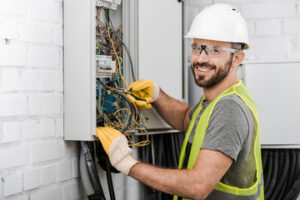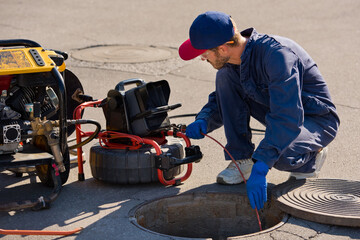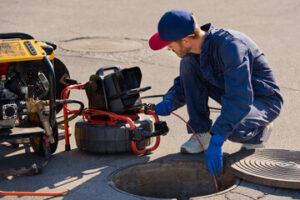Your Home Solutions hold up well under most conditions, but sometimes it needs to be repaired. This might be a matter of replacing a light bulb or a switch, or it could require the replacement of a whole strip of wiring or even an entire service panel.

Various power issues can pop up, from a tripped circuit breaker to flickering lights. Usually, these can be fixed with the following steps:
If your fuse board or breaker switch trips, that usually indicates an electrical problem in the house. It may seem inconvenient, but it’s important to understand why this is happening and call a professional electrician for an electrical repair as soon as possible.
Fuse switches and RCDs are designed to sense a short or unusual electrical current change and immediately cut the power. This is to prevent any harm to you or your appliances, and it means that you cannot simply reset the breaker or fuse and turn back on the lights and electrics.
A faulty appliance or an overloaded circuit can cause your breaker to trip. This is because the metal ribbon inside the fuse burns through, and all lights or sockets on the affected circuit go dead. Faulty electrical wiring can also do this, particularly old wires that have corroded over time.
To determine which of these is the cause, start by locating your fuse box and opening it. It’s typically in a utility room, porch, or garage and should be marked to indicate which circuits it controls. Once open, you’ll see a row of breakers with a switch on each one. If the switch is flipped to the Off position, the breaker has been tripped.
A good rule of thumb is to unplug all appliances on a tripped circuit, then try switching them back on again – and only if the breaker doesn’t trip immediately and stays in the on position. This will help you narrow down which appliance is causing the issue so you can call an electrician for an electrical repair to fix it.
The other possibility is that the breaker keeps tripping even with nothing plugged in. If it continues to do so after you’ve switched on appliances and reset the breaker, this is a sign of a faulty plug or wiring. You’ll need a professional electrician to replace or fix the device and its cable and to repair any damage to the wires in your house’s walls or the junction boxes.
Most homeowners will experience a dead electrical outlet at some point. It can be extremely frustrating if this happens in a room you use frequently. Fortunately, there are some things you can try before calling an electrician to solve the problem.
First, make sure your breaker or fuse hasn’t been tripped. Then, if it has been, reset it and check if your outlets or switches are working properly. If not, you’ll need to replace the fuse or breaker with an identical one.
Another possible cause of an electric outlet not working is a loose connection. You can check this by removing the outlet from its frame (only after ensuring your breaker is off) and inspecting the links of the wires. Make sure the ends of each wire are securely fastened underneath each screw. Also, look for a small black area around the screw terminals. This is a sign of a loose connection that causes excess heat, leading to eventual failure.
If you have a GFCI outlet in the room where your outlet isn’t working, try pressing its reset button. GFCIs are designed to shut off power when they detect a flow of current that could pose a danger to people or pets. They typically trip when plugged into wet or electrically charged surfaces, like a sink.
Finally, if you can’t get your outlet to work after trying these tips, it’s probably time to call an electrician. They’ll be able to diagnose and repair the problem using their training, tools, and extensive knowledge of electrical systems.
Flickering lights aren’t just annoying – they can signify a much larger electrical problem that needs expert repair. Depending on the severity of the flickering, it may be something as minor as a loose light bulb, or it could indicate a major problem that can result in power loss and even fires. Keeping an eye out for these signs and understanding what they mean can help you decide when to call an electrician for electrical services.
One of the most common reasons for flickering lights is a fluctuation or reduction in household voltage. This can be caused by several things, such as using large appliances (like refrigerators and air conditioners) simultaneously or a power outage. Abrupt changes in voltage can damage electronics and even cause an electrical fire.
Another reason for flickering lights is an overloaded circuit. If you have a lot of appliances on the same course, they’ll draw a significant amount of electricity, which can overload the system and cause the lights to flicker. To reduce this, you can try putting your appliances on different circuits, but it’s best to have an electrician check out the system and recommend the best options.
Finally, a common reason for flickering lights is damaged wiring. This can result from insulation deteriorating on old wires or even animals chewing through them. Damaged wiring can create a fire hazard as it is prone to arcing, which is dangerous for you and your family.
We look forward to helping you with all of your electrical service needs!
Over time, electrical cords, cables, wires, and flexes can become damaged. If the outer sheath is broken or worn away, the conductors inside are exposed and can easily cause an electric shock. In addition, the exposed wiring can also cause fire hazards. It is important to repair any broken wiring as soon as possible before it becomes a serious safety issue.
Electrical wiring is often hidden behind walls or in the ceiling of your home and can be difficult to access. However, even though you may not have a lot of room to work, it is still possible to repair or splice together wiring without tearing open the wall or ceiling.
First, turn off power to the circuit you are performing on by shutting down the breaker that supplies it in your home’s circuit breaker panel. Next, remove the faulty cable section, strip back the sheathing two inches on either side of the damage, and expose the copper wires inside. Ensure that all the exposed copper wires are unfused and do not touch each other; if they are, you will need to fuse them together by soldering or using a special splice connector like a lever connector.
If the cable has only been cut and not completely severed, then you can use a soldering iron to melt a piece of heat-shrink tubing onto the ends of the exposed wires to seal and insulate them. Make sure you use a quality soldering iron and don’t overheat the tip, as this could damage the wire insulation or even the metal conductors within.
If you cannot fix the wire with a soldering iron, another option is to use a lever connector, which can be purchased at most hardware stores. The splice connectors allow you to pull out a lever and insert the bare end of a wire, then close the lever to establish a strong and safe connection. If you are unsure how to fix your damaged wiring or are uncomfortable working with electricity, it is always best to leave the job to a professional electrician.


